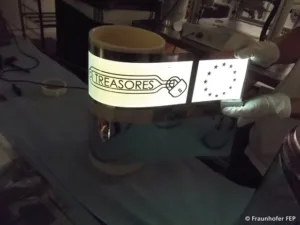The TREASORES project ((Transparent Electrodes for Large Area Large Scale Production of Organic Optoelectronic Devices) is a European project, established in late 2012, aiming to develop technologies to reduce the production costs of certain organic electronics. These included solar cells and LED lighting panels. As well as seven patent applications, TREASORES has developed and scaled up production processes for several new transparent electrode and barrier materials. These will be used in next-gen flexible optoelectronics.
A roll of OLED light sources, with the project logo, was created using roll-to-roll techniques at Fraunhofer FEP in Germany, on a thin silver electrode developed (within the project) by Rowo Coating GmbH.Three of the project’s electrode-on-flexible-substrate processes, using carbon nanotubes, metal fibres or thin silver, are already being produced commercially, or are expected to be this year. The new electrodes have been tested with several types of optoelectronic devices. They have been found to be especially suitable for next-gen lighting sources and solar cells.
Such processing techniques will be used to lower the cost of light source and solar cell production in the future. They also require flexible and transparent electrodes, and water impermeable barriers – also developed within the project. The electrodes are ‘at least technically as good’ as ITO electrodes, but will be cheaper to manufacture and do not rely on indium imports.
An OLED light source produced using the electrodes was said by Tomasz Wanski, from Fraunhofer, to be very homogenous over a large area, with an efficiency of 25lm/W. This is as good as OLEDs produced using a sheet-to-sheet process.
New test methods were developed by the National Physical Laboratory in the UK during the project. These were designed to ensure that the electrodes would still work after being repeatedly bent, and may become a standard in the field.
New approaches to transparent barrier foils have also been developed, tested and production scaled up. High-performance and low-cost barriers were developed, and it is expected that Switzerland’s Amcor Flexibles Kreuzlingen will adopt the technology, after further development.
By combining the production of barriers with electrodes (instead of using two separate plastic substrates), the project has shown that production costs can be further reduced and devices made thinner and more flexible.

